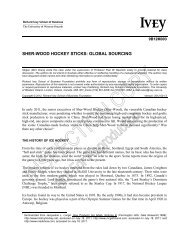foundation of canada asia pacific - Content Tagged with
foundation of canada asia pacific - Content Tagged with
foundation of canada asia pacific - Content Tagged with
Create successful ePaper yourself
Turn your PDF publications into a flip-book with our unique Google optimized e-Paper software.
STATISTICAL APPENDIX<br />
ASIAN MOTHER TONGUES OF MAJOR CANADIAN CITIES (% <strong>of</strong> population)<br />
Mother Tongue<br />
Vancouver<br />
Calgary<br />
Toronto<br />
Montreal<br />
Halifax<br />
Chinese<br />
Korean<br />
Japanese<br />
Tagalog (Pilipino)<br />
Vietnamese<br />
Other Southeast Asian<br />
Punjabi<br />
Gujarati<br />
Hindi<br />
Tamil<br />
Other Indian Languages<br />
Other Asian Languages<br />
Total Asian Languages<br />
Total Population<br />
13.2<br />
0.8<br />
0.8<br />
1.3<br />
0.8<br />
0.4<br />
3.8<br />
0.3<br />
0.8<br />
0.1<br />
0.3<br />
0.1<br />
22.5<br />
1,813,935<br />
4.5<br />
0.2<br />
0.2<br />
0.8<br />
0.9<br />
0.3<br />
1.0<br />
0.4<br />
0.2<br />
0.0<br />
0.4<br />
0.1<br />
9.0<br />
815,985<br />
6.8<br />
0.6<br />
0.2<br />
1.4<br />
0.8<br />
0.3<br />
1.5<br />
0.6<br />
0.3<br />
1.3<br />
1.0<br />
0.1<br />
14.7<br />
4,232,905<br />
1.2<br />
0.1<br />
0.0<br />
0.2<br />
0.6<br />
0.3<br />
0.2<br />
0.1<br />
0.1<br />
0.2<br />
0.3<br />
0.0<br />
3.5<br />
3,287,645<br />
0.5<br />
0.1<br />
0.0<br />
0.1<br />
0.1<br />
0.0<br />
0.1<br />
0.0<br />
0.1<br />
0.0<br />
0.2<br />
0.0<br />
1.2<br />
329,750<br />
77<br />
Source: Adapted from Statistics Canada, Nation Series Package No. 4: Mother Tongue, Home<br />
Language and Official/Non-Official Languages (Cat. No. 93F0024XDB9600).<br />
Note: Mother Tongue is the first language learned by a child.<br />
PER CAPITA INCOME MOVEMENTS<br />
Countries<br />
GNP PER CAPITA<br />
(IN CURRENT US $)<br />
GNP PER CAPITA, ADJUSTED FOR<br />
PURCHASING POWER PARITY<br />
1996 1998 1996 1998<br />
China<br />
Hong Kong (SAR)<br />
India<br />
Indonesia<br />
Japan<br />
Malaysia<br />
Philippines<br />
Singapore<br />
South Korea<br />
Thailand<br />
Canada<br />
620<br />
24,080<br />
420<br />
1,100<br />
40,910<br />
4,330<br />
1,160<br />
30,580<br />
10,590<br />
2,930<br />
19,330<br />
750<br />
23,670<br />
430<br />
680<br />
32,380<br />
3,600<br />
1,050<br />
30,060<br />
7,970<br />
2,200<br />
20,020<br />
2,870<br />
23,830<br />
1,610<br />
3,310<br />
24,030<br />
7,420<br />
3,580<br />
27,490<br />
12,970<br />
6,650<br />
21,220<br />
3,220<br />
22,000<br />
1,700<br />
2,790<br />
23,180<br />
6,990<br />
3,540<br />
28,620<br />
12,270<br />
5,840<br />
24,050<br />
Sources: World Bank, World Development Report 1999/2000 and World Bank, special request.<br />
Notes: PPP estimates <strong>of</strong> GNP per capita are calculated by converting GNP to US dollars using the<br />
purchasing power parity (PPP) exchange rate instead <strong>of</strong> the market exchange rate. The resulting<br />
estimates are expressed in international dollars, a unit <strong>of</strong> account that has the same purchasing power<br />
in each economy as the US dollar has in the US economy. World Development Report 1999/2000.



